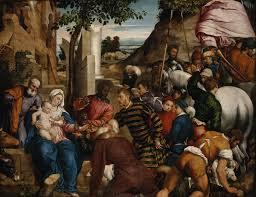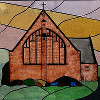
The painting above is entitled; ‘The adoration of the Magi’ and it was painted in about 1542 by Jacopo Del Ponte (‘nick-named’ Bassano from the town the he came from ‘Bassano del Grappa’) near Venice.
Bassano’s work is one of my all time favourite paintings. Why? For many reasons; such as his use of strong colour, his subject matter and the fact it was one of the first paintings that I learned to ‘read’. Most of us will get‘Nativity’ scenes on Christmas cards this year but have you ever taken a good look at them and wondered what the different elements in the painting are all about? How does the artist want you to read their work? What is Bassano saying to us his viewers?
Bassano has taken as his inspiration the story in Chapter 2 of the Gospel according to St.Matthew, where Matthew records the visit of wise men from the East:
"In the time of King Herod, after Jesus was born in Bethlehem of Judea, wise men from the East came to Jerusalem, asking, ‘Where is the child who has been born king of the Jews? For we observed his star at its rising, and have come to pay him homage.’ When King Herod heard this, he was frightened, and all Jerusalem with him; and calling together all the chief priests and scribes of the people, he inquired of them where the Messiah was to be born." They told him, ‘In Bethlehem of Judea; for so it has been written by the prophet:
“And you, Bethlehem, in the land of Judah, are by no means least among the rulers of Judah; for from you shall come a ruler who is to shepherd my people Israel.” ’
"Then Herod secretly called for the wise men and learned from them the exact time when the star had appeared. Then he sent them to Bethlehem, saying, ‘Go and search diligently for the child; and when you have found him, bring me word so that I may also go and pay him homage.’ When they had heard the king, they set out; and there, ahead of them, went the star that they had seen at its rising, until it stopped over the place where the child was. When they saw that the star had stopped, they were overwhelmed with joy. On entering the house, they saw the child with Mary his mother; and they knelt down and paid him homage. Then, opening their treasure-chests, they offered him gifts of gold, frankincense, and myrrh. And having been warned in a dream not to return to Herod, they left for their own country by another road."
In the centre of the painting you have the three wise men, representing different races and ages of humanity. St.Matthew is trying to tell us in his words that the Christ was born for ALL God’s people and not just the Hebrews, so is Bassano trying to do the same in his painting. Hence the black man, the old man and the younger man. The wise men or kings are offering their gifts to the child; gold - acknowledging his kingship; frankincense - acknowledging his divinity (incense is used to represent our prayers ascending to God in heaven) and myrrh - foreshadowing Christ’s death (myrrh was used in embalming).
The baby Jesus is raising his hand in blessing and acceptance of the gifts and in doing so acknowledges who he is to the wise men. In these paintings the baby Jesus is usually shown naked, emphasising his belly button as proof that Jesus was both fully human and divine. All humans have a belly button, is the reasoning here. Joseph also is usually depicted, as here, as an older man with a walking stick, empathising the fact that he was too old to have been Jesus father and that Mary was a virgin when Jesus was born. If you look carefully around the Holy Family you will see other symbols telling us who Jesus is and how his life will develop.
The Holy Family is not in a stable but in some form of ruined temple, this emphasises the transition from the Old Testament to the New Testament with the birth of Jesus, the Messiah, the promised Saviour. Look at the stable pictures in other paintings and they too are falling down, indication the passing away of the old and the birth of the new age in Christ. You also have the ox looking at Jesus and the donkey looking away. The ox is a symbol for the new testament and the donkey one for the old testament. In Hebrew society the king always rode a donkey in processions. The cut tree in front of Jesus foreshadows his crucifixion on the cross.
Christmas cards with their Nativity images are worth studying, have a look at yours this year and ponder as you ‘read’ the painting what all the different bits mean and why the artist put them in. Nothing in any painting is there by accident. In Bassano’s painting there is so much going on and I have only given you a little insight but I hope you will like the painting as much as I do.
The Nativity has been a source of inspiration to many artists over the centuries and to countless millions of Christians as well. So strong is the truth it portrays that it remains, and I believe will always remain, an inspiration for the human race for eternity.
The simple message of the Nativity is that in the birth of Jesus (the Incarnation) God became human to show us all how much we are loved and how we can in God hope for a better future. With all the pain and difficulties we have all faced in 2020 let us hope that the hope and love of Christmas will encourage us to look forward to 2021 with joy in our hearts.
May Christ, who by his incarnation gathered into one all things earthly and heavenly, fill you with joy and peace; and bless you now at Christmas and in the new year to come. Amen.
